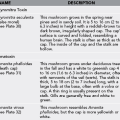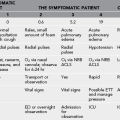Injuries From Nonvenomous Aquatic Animals
General Treatment
1. If the bill or spine of an animal is seen to be lodged in the patient and has penetrated deeply into the chest, abdomen, or neck (this is extremely rare) and may have violated a critical blood vessel or the heart, it should be managed as would be a weapon of impalement (e.g., a knife). In this case, the impaling object should be left in place if possible and secured from motion until the patient is brought to a controlled operating room environment where emergency surgery can be performed to guide its extraction and control bleeding that may occur upon its removal.
2. Irrigate all wounds with a sterile diluent, preferably normal saline (NS) solution. Seawater is not recommended because it carries a hypothetical risk for infection. Use disinfected potable or tap water if NS solution is not available.
a. Note that proper irrigation technique involves using a 19-gauge needle or 18-gauge plastic IV catheter attached to a syringe to deliver a pressure of 10 to 20 psi.
b. Flush a minimum of 100 to 250 mL of irrigant through each wound.
c. If the wound was caused by a stingray, stonefish, scorpion fish, or lionfish, warm the irrigant to 45° C (113° F) (see Chapter 53).
3. Add an antiseptic to the irrigation fluid. Add concentrated povidone-iodine solution (not “scrub”) to the irrigant to achieve a final concentration of 1% to 5%. Allow a contact time of 1 to 5 minutes. After irrigation with the antiseptic-containing solution, thoroughly irrigate the wound with unadulterated NS solution.
4. With a coral cut or abrasion, scrub the area to remove debris that cannot be irrigated from the wound.
5. Remove any crushed or devitalized tissue using sharp dissection.
6. In the field, perform wound closure using the technique that is least constrictive and therefore less prone to trap bacteria, which could initiate a wound infection. From an infection risk perspective, unless wound preparation equivalent to that achieved in a hospital is undertaken, it is often better to approximate the wound edges with adhesive strips or loosely placed sutures than to perform a tight approximation of the margins (see Chapter 20).
7. At the earliest sign of wound infection, release sufficient fasteners to allow prompt and thorough drainage from the wound. Initiate antibiotic therapy.
Antibiotic Therapy
1. Be aware that minor abrasions or lacerations (e.g., coral cuts, superficial sea urchin puncture wounds) do not require prophylactic antibiotics in a person with normal immunity. However, for persons who are chronically ill (e.g., diabetes, hemophilia, thalassemia), are immunologically impaired (e.g., leukemia, AIDS, chemotherapy, prolonged corticosteroid therapy), or have serious liver disease (e.g., hepatitis, cirrhosis, hemochromatosis), particularly those with elevated serum iron levels, immediately begin a regimen of oral ciprofloxacin, trimethoprim/sulfamethoxazole (co-trimoxazole), or tetracycline/doxycycline. Note that penicillin, ampicillin, amoxicillin, and erythromycin are not acceptable alternatives. Although other quinolones have not been extensively tested against Vibrio species, they may be useful alternatives.
2. Note that the appearance of an infection indicates the need for prompt débridement and antibiotic therapy. If an infection develops, choose antibiotic coverage that will also be efficacious against Staphylococcus and Streptococcus species. Vancomycin is recommended in the event of methicillin resistance.
3. From an infection perspective, consider the following as serious injuries: large lacerations, extensive or deep burns, deep puncture wounds, and a retained foreign body.
a. These injuries may be caused by shark, barracuda or other fish bites, stingray spine wounds, an impalement from a fish bill, any spine puncture that enters a joint space, and full-thickness coral cuts.
b. If the patient will require hospitalization for any of these serious injuries and intravenous antibiotics are accessible, the recommended drugs for prophylaxis include gentamicin, tobramycin, amikacin, and trimethoprim-sulfamethoxazole. Cefoperazone, cefotaxime, and ceftazidime may not be effective; if they are used, they should be combined with another agent listed or with tetracycline.
4. Manage infected wounds with antibiotics as noted earlier, with consideration of adding imipenem-cilastatin or meropenem for severe, progressive infections and sepsis.
5. If a wound infection is minor and has the appearance of a classic erysipeloid reaction (Erysipelothrix rhusiopathiae) (see Plate 34), penicillin, cephalexin, or ciprofloxacin should be administered.
Injuries Caused by Sharks and Barracuda
Treatment
1. Control active hemorrhage with pressure if possible. If necessary, ligate large disrupted vessels.
2. Insert at least two large-bore intravenous lines. Obtain intraosseous access as needed.
3. Keep the patient well oxygenated and warm.
4. Transport the patient to a proper emergency facility equipped to handle major trauma and appropriate surgical management of the wounds.
5. If the wound is more than minor, administer a prophylactic antibiotic (see earlier).
6. Manage abrasions caused by contact with sharkskin as if they were second-degree burns. Cleanse the wound thoroughly; then apply a thin layer of mupirocin (Bactroban) ointment or silver sulfadiazine cream under a sterile dressing.
Prevention of Shark Attacks
1. Avoid shark-inhabited water, particularly at dawn, dusk and night.
2. Do not swim through schools of bait fish in the presence of sharks.
3. Do not enter waters posted with shark warnings.
4. Do not wander too far from shore.
5. Do not swim with animals (e.g., dogs or horses) in shark inhabited waters.
6. Photograph hazardous sharks from within the confines of a protective cage.
7. Swimmers should remain in groups.
8. Avoid turbid water, drop-offs, deep channels, inlets, mouths of rivers, and sanitation waste outlets.
9. Do not swim in waters frequented by recreational or commercial fishers.
10. Do not swim in water that has been recently churned up by a storm.
11. Be alert when crossing sandbars.
12. Do not enter the water with an open wound, particularly if it is bleeding.
13. Do not dive during menses (controversial).
14. Do not wear flashy metal objects.
15. Do not dive or swim in the presence of spear fishermen. Do not carry captured fish. Tether captured fish at a sufficient distance from divers.
16. Be alert when schools of fish behave in an erratic manner or when pods of porpoises cluster more tightly or head toward shore.
17. Do not tease or corner a shark.
18. Do not splash on the surface or create a commotion in the water.
19. If a shark appears in shallow water, swimmers should leave the water with slow, purposeful movements, facing the shark if possible and avoiding erratic behavior that could be interpreted as distress.
Moray Eel Injury
Treatment
1. Explore each wound to locate any retained teeth.
2. Irrigate each wound copiously.
3. Because the risk for infection is high, do not suture any puncture wound unless it is necessary temporarily to control hemorrhage.
4. If the wound is extensive and more linear in configuration (resembling a dog bite), débride the wound edges and loosely approximate them with nonabsorbable sutures or staples.
Sea Lion Bite
“Seal finger” follows a bite wound from a seal or sea lion or from contact of even a minor skin wound with the animal’s mouth or pelt. The signs and symptoms include an incubation period of 1 to 15 (typically, 4) days, followed by painful swelling of the digit, with or without joint involvement. Severe pain may precede the appearance of the initial furuncle, swelling, or stiffness. As the lesion worsens, the skin becomes taut and shiny and the entire hand may swell and take on a brownish-violet hue (see Plate 35). Mycoplasma species may be the inciting pathogens. The treatment is tetracycline 1.5 gm PO initially, followed by 500 mg PO q6h for 4 to 6 weeks. Fluoroquinolone or macrolide antibiotics may be useful if tetracycline is not available.
Needlefish Injury and Other Impalements
Treatment
1. If the bill or spine of an animal is seen to be lodged in the patient and has penetrated deeply into the chest, abdomen, or neck (this is extremely rare) and may have violated a critical blood vessel or the heart, it should be managed as would be a weapon of impalement (e.g., a knife). In this case, the impaling object should be left in place if possible and secured form motion until the patient is brought to a controlled operating room environment where emergency surgery can be performed to guide its extraction and control bleeding that may occur upon its removal.
2. Be aware that the major risk is wound infection caused by the retained organic material. Another risk is vascular injury.
3. Cleanse the wound thoroughly, then débride and dress it.
4. If the wound is more than superficial, administer a prophylactic antibiotic (see earlier). If the distal circulation is impeded, undertake immediate evacuation.
Coral Cuts and Abrasions
Signs and Symptoms
1. Initial reactions: stinging pain, erythema, pruritus
2. Break in skin surrounded within minutes by erythematous wheal, which fades over 1 to 2 hours
3. Red, raised welts and local pruritus accompanied by low-grade fever and malaise, known as “coral poisoning”
4. Progresses to cellulitis with ulceration and tissue sloughing
Treatment
1. Promptly and vigorously scrub the wound with soap and water, and then irrigate copiously to remove all foreign material.
2. Use hydrogen peroxide to bubble out tiny particles of organic material deposited from the surface of the coral. Follow with a thorough NS solution or tap water irrigation.
3. If a stinging sensation is prominent, be aware that envenomation may have occurred. Briefly rinse the area with diluted (half-strength or 2.5%) household vinegar to diminish discomfort. Follow with a thorough NS solution or tap water irrigation.
4. If a coral-induced laceration is severe, close it with adhesive strips rather than sutures, if possible, because the margins of the wound are likely to become inflamed and necrotic. Be aware that serial débridement may become necessary.
5. To achieve a bed of healing tissue, apply twice-daily, sterile, wet-to-dry dressings using NS solution or a dilute antiseptic (e.g., povidone-iodine 1% to 5%). Alternatively, use a nontoxic topical antiseptic ointment (e.g., bacitracin, mupirocin, polymyxin B-bacitracin-neomycin) sparingly and cover the wound with a nonadherent dressing.
6. Be aware that despite the best efforts at primary irrigation and decontamination, the wound may heal slowly, with moderate to severe soft tissue inflammation and ulcer formation. Débride all devitalized tissue regularly using sharp dissection. Continue this regimen until healthy granulation tissue is formed.
7. Treat any wound that appears infected with an antibiotic (see earlier).






